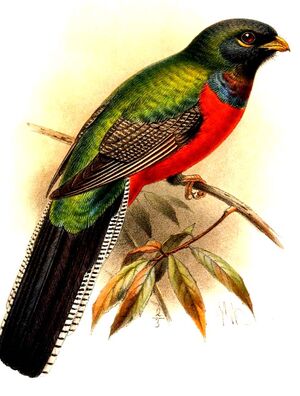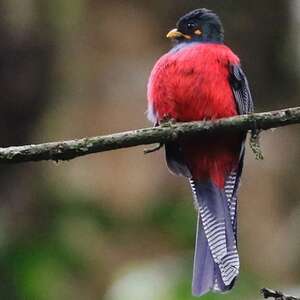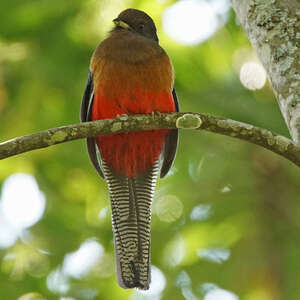Bar-tailed Trogon
Apaloderma vittatum - Trogon à queue barrée
Identification
The Bar-tailed Trogon (scientific name Apaloderma vittatum, English name Bar-tailed Trogon) is a conciliatory trogon. George Ernest Shelley (1840-1910), an English ornithologist, discovered it in 1882 in Tanzania. Ornithology leading to everything, it is important to know that he was the nephew of Mary Shelley who wrote the famous novel Frankenstein. The Bar-tailed Trogon is 27 cm long and, like all trogons, has a very marked dimorphism. The male has a pale yellow beak, with a brown iris topped by a thin yellow eyebrow line, and below the eye two orange marks in line with the beak, and at the parotid area are characteristic of the species. The head has an indeterminable black coloration! The parotids and nape are rather black, the forehead is dark green bordering on black, the throat is dark blue-coal passing to green-bronze on the upper chest and a blue-ultramarine band separates the chest from the bright red belly. The mantle and back are emerald green, the small and medium wing coverts keep the green background of the back and are "spotted" with small black and white waves, the large coverts and remiges show black and white vermiculations, a characteristic mark of most trogons. The black primary remiges are outlined in white at the margins. The central rectrices are purple-gray and the three pairs of external rectrices are white with horizontal black lines. The female keeps the same yellow beak, with a slightly grayish culmen, and the male's orange marks; the head is chestnut brown, the parotids are dark brown. The chest is chestnut brown to lighten to the belly which is faded red almost rose, the mantle and back take on the emerald green color of the male and the coverts are also vermiculated.The legs are pale orange. Juveniles have a dark brown head, the orange markings of the adult, below the eye and along the beak, are white, the chest is a patchwork of green, red and light brown spots, with age the red colouration of the belly will become more prominent.
Subspecific information monotypic species
Foreign names
- Trogon à queue barrée,
- Trogón montano,
- republicano-de-cauda-barrada,
- Bergtrogon,
- szalagosfarkú trogon,
- Bandstaarttrogon,
- Trogone codabarrata,
- bandtrogon,
- Blåbeltetrogon,
- trogónovec pásochvostý,
- trogon horský,
- Blåbrystet Trogon,
- viirupyrstötrogoni,
- trogon cuabarrat,
- afrotrogon prążkowany,
- Горный африканский трогон,
- シマオアフリカキヌバネドリ,
- 斑尾咬鹃,
- bandtrogon,
- 斑尾咬鵑,
Voice song and call
The Bar-tailed Trogon emits a short, high pitched wup-wup-wup which is repeated between 7 and 14 times and increases in intensity. The bird stops for 10 to 15 seconds and often resumes over very long periods. The female produces a more muffled, chee-uu sound more like a moan which decreases in intensity.
Habitat
The Bar-tailed Trogon prefers humid, mountainous forests between 600 and 3,000 m, primary forests with a noticeable presence of epiphytes, Cyathea ferns, moss and lichen, and usually stays around 1,600 m. Often observed near streams and in very wet environments. The fragmentation of its distribution suggests that it is very dependent on its biotope, it often accompanies the Narina Trogon but always remains higher.
Behaviour character trait
Dietfeeding habits
Reproduction nesting
The breeding seasons are from November to January on Bioko Island, October and December to February in Cameroon, and from February to May in the Democratic Republic of Congo.
Like others in the Apaloderma genus, the Bar-tailed Trogon is monogamous and very territorial, defending a territory that can range from 1 to 5 hectares. There is little information available about the breeding of the Bar-tailed Trogon, with the nest being dug in the trunk of a dead tree at a height of about 2 m. The entrance of the nest is 17 to 18 cm in diameter, with the chamber located 20 cm below the entrance lined with small pieces of wood. The clutch is normally two eggs, but there is no information available on incubation and feeding of the chicks.Geographic range
Its distribution range is a succession of zones ranging from West Africa to East Africa with large regions where it does not appear. It can be found in southern Nigeria, Cameroon, particularly Mount Cameroon and Mount Oku, on Bioko Island in the Gulf of Guinea. No more traces until the Itombwe Reserve in the Democratic Republic of Congo, on the edges of Lake Tanganyka, in Rwanda in the Nyungwe Forest, in Uganda, in Burundi. East Africa hosts it in Tanzania in the Arusha Park, present in Zambia in the Chowo Forest and on the Nyika Plateau.
Threats - protection
IUCN conservation status
concern
in the Wild
threatened
evaluated
At the moment, the Bar-tailed Trogon is without any particular concern, however Birdlife and IUCN note a trend towards a decrease in population numbers due to deforestation and human activity. Its distribution range is disparate, likely demonstrating its need for a particular habitat. The populations of Bar-tailed Trogons that reside in higher altitudes are probably safe for now, but for how much longer?
Sources of information
- IOC World Bird List (v15.1), Gill, F and D Donsker (Eds). 2025-12-07.
- A Natural history of the Trogonidae, Joseph M.Forshaw Albert Earl Gilbert
- Scientific Birds Names, James A.Jobling
- Vol. 6 - Handbook of the Birds of the World, Josep del Hoyo-Andrew Elliott-Jordi Sargatal
- xeno-canto, Sharing bird sounds from around the world,
- Avibase, Lepage Denis
- BirdLife International, BirdLife International
- HBW Alive,
- The internet Bird Collection,
- Wikipédia, Wikipedia, The Free Encyclopedia
Other sources of interest
 Specification sheet created on
01/08/2023 by Anne et Gabriel Leboff
Specification sheet created on
01/08/2023 by Anne et Gabriel LeboffTranslation by AI Oiseaux.net
© 1996-2025 Oiseaux.net
- Accipitriformes
- Aegotheliformes
- Anseriformes
- Apodiformes
- Apterygiformes
- Bucerotiformes
- Caprimulgiformes
- Cariamiformes
- Casuariiformes
- Charadriiformes
- Ciconiiformes
- Coliiformes
- Columbiformes
- Coraciiformes
- Cuculiformes
- Eurypygiformes
- Falconiformes
- Galliformes
- Gaviiformes
- Gruiformes
- Leptosomiformes
- Mesitornithiformes
- Musophagiformes
- Nyctibiiformes
- Opisthocomiformes
- Otidiformes
- Passeriformes
- Pelecaniformes
- Phaethontiformes
- Phoenicopteriformes
- Piciformes
- Podargiformes
- Podicipediformes
- Procellariiformes
- Psittaciformes
- Pterocliformes
- Rheiformes
- Sphenisciformes
- Steatornithiformes
- Strigiformes
- Struthioniformes
- Suliformes
- Tinamiformes
- Trogoniformes















